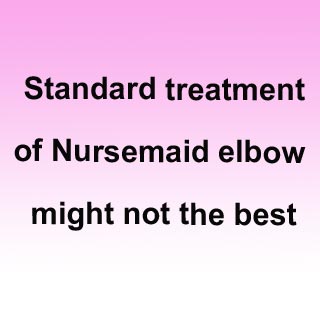
It may generally be fixed by a physician who may maneuver one of the bones of the elbow joint back into proper position. A new review now claims that the textbook way of treating Nursemaid’s elbow may not be the best technique. Detecting nursemaid’s elbow could be a little difficult, as generally the elbow is not swollen or tender to the touch, and an X-ray may not be able to disclose the slippage. This was mentioned by Michael Davis, M.D., a pediatrician at the Nemours Children’s Clinic in Pensacola, Fla.
Instead, a parent or doctor may be able to identify the problem if a child holds her arm to her side with the palm of the hand facing in the direction of the back, while complaining of pain and not using that arm. Usually, physicians treat the conditions by sliding the radial head back into place by twisting the forearm so that the child’s palm is facing up, while occasionally bending the arm at the elbow.
Reviewers led by Marjolein Krul, M.D., a general practice researcher at the Erasmus MC University Medical Center in Rotterdam, Netherlands, commented, “While this has become standard practice, it is not always successful.â€
Instead, the review of Krul and colleagues alleged that a method that twists the forearm so that the palm is facing down might be a more effectual and less painful technique of treating the injury. Still, the researchers warn that the palm-down method may be only somewhat more effectual, based on the three, mostly low-quality researches that they analyzed.
Krul mentioned, “Pulled elbow is almost only seen among young children, because their ligaments and the tissue surrounding the radial head are relatively soft. The injury is described as being most common in the left arm and among girls.â€
In their investigation of three researches with about 313 children, all who were younger than seven years old, it was found that the physicians who apparently applied the palm-down technique were supposedly more successful in popping the radial head back into position in the first attempt, as opposed to those who used the palm-up method.
Krul mentioned that both methods are generally safe, although bruising can occur and they can be painful. Davis, who advises caution when pulling on the child’s arm, remarked that children who have had nursemaid’s elbow may be at a slight increased risk for repeat injury.
The review appears in the latest issue of The Cochrane Library, a publication of The Cochrane Collaboration, an international organization that evaluates medical research.
